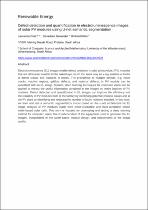 ResearchSpace
ResearchSpace
Defect detection and quantification in electroluminescence images of solar PV modules using U-net semantic segmentation
JavaScript is disabled for your browser. Some features of this site may not work without it.
- ResearchSpace
- →
- Research Publications/Outputs
- →
- Journal Articles
- →
- View Item
| dc.contributor.author |
Pratt, Lawrence E

|
|
| dc.contributor.author |
Govender, Devashen

|
|
| dc.contributor.author |
Klein, R

|
|
| dc.date.accessioned | 2021-08-16T12:51:27Z | |
| dc.date.available | 2021-08-16T12:51:27Z | |
| dc.date.issued | 2021-11 | |
| dc.identifier.citation | Pratt, L.E., Govender, D. & Klein, R. 2021. Defect detection and quantification in electroluminescence images of solar PV modules using U-net semantic segmentation. <i>Renewable Energy, 178.</i> http://hdl.handle.net/10204/12083 | en_ZA |
| dc.identifier.issn | 0960-1481 | |
| dc.identifier.issn | 1879-0682 | |
| dc.identifier.uri | https://doi.org/10.1016/j.renene.2021.06.086 | |
| dc.identifier.uri | http://hdl.handle.net/10204/12083 | |
| dc.description.abstract | Electroluminescence (EL) images enable defect detection in solar photovoltaic (PV) modules that are otherwise invisible to the naked eye, much the same way an x-ray enables a doctor to detect cracks and fractures in bones. The prevalence of multiple defects, e.g. micro cracks, inactive regions, gridline defects, and material defects, in PV module can be quantified with an EL image. Modern, deep learning techniques for computer vision can be applied to extract the useful information contained in the images on entire batches of PV modules. Defect detection and quantification in EL images can improve the efficiency and the reliability of PV modules both at the factory by identifying potential process issues and at the PV plant by identifying and reducing the number of faulty modules installed. In this work, we train and test a semantic segmentation model based on the u-net architecture for EL image analysis of PV modules made from mono-crystalline and multi-crystalline silicon wafer-based solar cells. This work is focused on developing and testing a deep learning method for computer vision that is independent of the equipment used to generate the EL images, independent of the wafer-based module design, and independent of the image quality. | en_US |
| dc.format | Abstract | en_US |
| dc.language.iso | en | en_US |
| dc.relation.uri | https://www.sciencedirect.com/science/article/pii/S0960148121009526 | en_US |
| dc.source | Renewable Energy, 178 | en_US |
| dc.subject | Electroluminescence | en_US |
| dc.subject | EL | en_US |
| dc.subject | Solar Photovoltaic | en_US |
| dc.subject | Semantic segmentation | en_US |
| dc.subject | Machine learning | en_US |
| dc.subject | U-net | en_US |
| dc.title | Defect detection and quantification in electroluminescence images of solar PV modules using U-net semantic segmentation | en_US |
| dc.type | Article | en_US |
| dc.description.pages | 1211-1222 | en_US |
| dc.description.note | © 2021 Elsevier Ltd. All rights reserved. Due to copyright restrictions, the attached PDF file only contains the abstract of the full-text item. For access to the full-text item, please consult the publisher's website: https://www.sciencedirect.com/science/article/pii/S0960148121009526 | en_US |
| dc.description.cluster | Smart Places | en_US |
| dc.description.cluster | Next Generation Enterprises & Institutions | |
| dc.description.impactarea | Energy Supply and Demand | en_US |
| dc.description.impactarea | Artificial Intelligence | |
| dc.identifier.apacitation | Pratt, L. E., Govender, D., & Klein, R. (2021). Defect detection and quantification in electroluminescence images of solar PV modules using U-net semantic segmentation. <i>Renewable Energy, 178</i>, http://hdl.handle.net/10204/12083 | en_ZA |
| dc.identifier.chicagocitation | Pratt, Lawrence E, Devashen Govender, and R Klein "Defect detection and quantification in electroluminescence images of solar PV modules using U-net semantic segmentation." <i>Renewable Energy, 178</i> (2021) http://hdl.handle.net/10204/12083 | en_ZA |
| dc.identifier.vancouvercitation | Pratt LE, Govender D, Klein R. Defect detection and quantification in electroluminescence images of solar PV modules using U-net semantic segmentation. Renewable Energy, 178. 2021; http://hdl.handle.net/10204/12083. | en_ZA |
| dc.identifier.ris | TY - Article AU - Pratt, Lawrence E AU - Govender, Devashen AU - Klein, R AB - Electroluminescence (EL) images enable defect detection in solar photovoltaic (PV) modules that are otherwise invisible to the naked eye, much the same way an x-ray enables a doctor to detect cracks and fractures in bones. The prevalence of multiple defects, e.g. micro cracks, inactive regions, gridline defects, and material defects, in PV module can be quantified with an EL image. Modern, deep learning techniques for computer vision can be applied to extract the useful information contained in the images on entire batches of PV modules. Defect detection and quantification in EL images can improve the efficiency and the reliability of PV modules both at the factory by identifying potential process issues and at the PV plant by identifying and reducing the number of faulty modules installed. In this work, we train and test a semantic segmentation model based on the u-net architecture for EL image analysis of PV modules made from mono-crystalline and multi-crystalline silicon wafer-based solar cells. This work is focused on developing and testing a deep learning method for computer vision that is independent of the equipment used to generate the EL images, independent of the wafer-based module design, and independent of the image quality. DA - 2021-11 DB - ResearchSpace DP - CSIR J1 - Renewable Energy, 178 KW - Electroluminescence KW - EL KW - Solar Photovoltaic KW - Semantic segmentation KW - Machine learning KW - U-net LK - https://researchspace.csir.co.za PY - 2021 SM - 0960-1481 SM - 1879-0682 T1 - Defect detection and quantification in electroluminescence images of solar PV modules using U-net semantic segmentation TI - Defect detection and quantification in electroluminescence images of solar PV modules using U-net semantic segmentation UR - http://hdl.handle.net/10204/12083 ER - | en_ZA |
| dc.identifier.worklist | 24850 | en_US |





